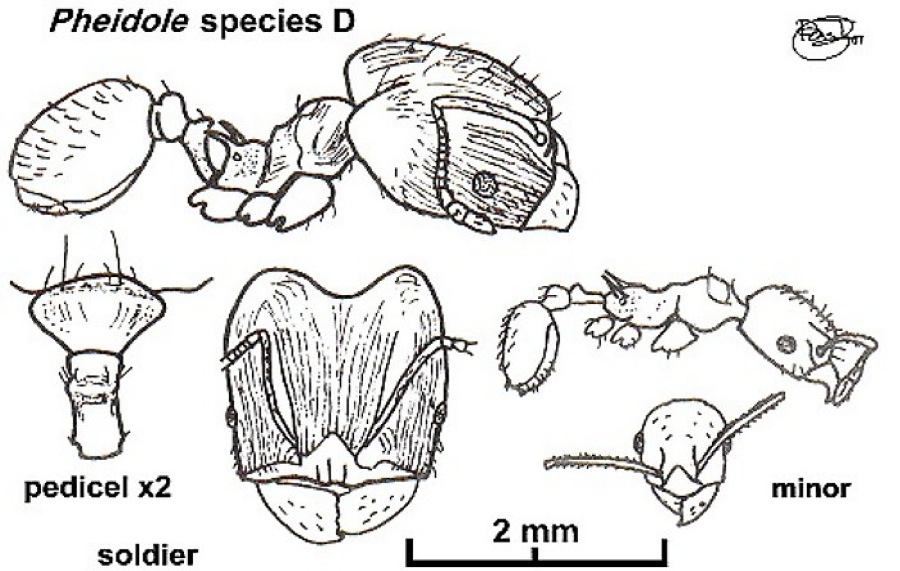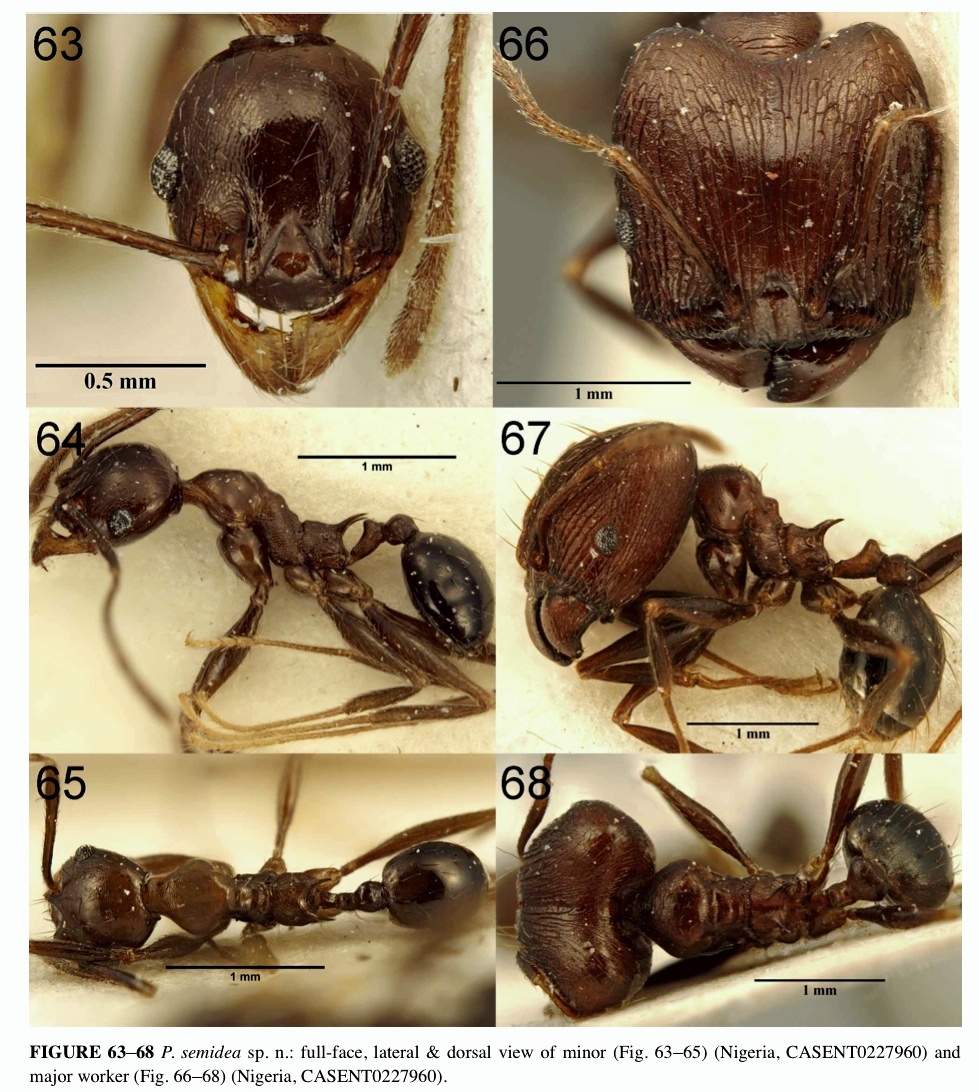Pheidole semidea Fischer, Peters & Hita
Garcia
  Type location Nigeria
(Fischer, Hita Garcia & Peters, 2012, 38, Figs. 63-68), Gambari,
22.vii.69, in log (B. Bolton) (BMNH: CASENT0227959). Paratypes: (2
major workers, 5 minor workers) same data as holotype (BMNH:
CASENT0227960, CASENT0227961). Type location Nigeria
(Fischer, Hita Garcia & Peters, 2012, 38, Figs. 63-68), Gambari,
22.vii.69, in log (B. Bolton) (BMNH: CASENT0227959). Paratypes: (2
major workers, 5 minor workers) same data as holotype (BMNH:
CASENT0227960, CASENT0227961).
major and minor described  . .
|
Diagnosis: Color
light to dark brown.
Major:
Frons with moderately long rugae, vertex weakly rugose-reticulate,
and posterolateral lobes with oblique rugulae. Mesonotal process in
lateral view almost right-angled, second process very shallow and
raised above level of dorsopropodeum. In profile, dorsopropodeum
anterior to propodeal spines longer than horizontal width of base of
spine. Postpetiole moderately wide (PWI 192–221) and standing hairs on
pronotum medially inclined.
Minor: Head shape rounded (CI 85–89), with
medially impressed occipital carina. Dorsal surfaces of head,
promesonotum and metasoma
smooth, at most superficially punctate. Second mesonotal process in
lateral view distinctly raised above level of anterior dorsopropodeum.
Petiole relatively short (PpLI: 126–144).
|
Description of major
worker:
Face entirely rugose-punctate, rugae relatively long and sometimes
interrupted on frons, posteriorly with some weak cross-meshes,
disappearing towards obliquely and weakly rugulose-punctate
posterolateral lobes. Outer corners of posterolateral lobes and
spaces between rugae on frons superficially punctate, laterally of
antennal scrobe irregularly rugose-reticulate. Scape with decumbent
pilosity. Promesonotum in lateral view short, posteriorly sub-angulate,
declivity short, anterodorsally and anterolaterally weakly
and irregularly rugulose-punctate, grading to superficially punctate
posteriorly on dorsopronotum, lateropronotum and mesonotum. First
mesonotal process right-angled, with a steep declivity. Second process
small or reduced to short, narrowly raised carina, but raised above
level of dorsopropodeum. Meso- and metapleuron punctate, with smooth
area on katepisternum and posteroventral metapleuron. Metapleural
carina relatively short and weak, gland scrobe weak to inconspicuous.
Dorsal and posterior propodeum smooth to superficially punctate, with
transverse rugula(e) between spines and moderately developed,
longitudinal rugula(e) posteriorly along spines. Petiole and
postpetiole punctate, except medial area of anterodorsal petiole. First
gastral tergite shagreened, posteriorly slightly weaker. Metatibia with
appressed pilosity. Acute, long standing hairs present on head,
postpetiole, dorsal gaster and pronotum, on the latter medially
inclined. Color reddish brown, gaster darker.
Measurements (holotype): HL 1.800, HW 1.760, SL 0.978, MDL 0.833,
EL 0.222, MFL 1.444, MTL 1.078, WL 1.429, PSL 0.300, PTH 0.333,
PPH 0.367, PTL 0.500, PPL 0.311, PTW 0.222, PPW 0.467, PW 0.800
Indices:
CI 98, SI 56, MDI 47, PSLI 17, PWI 45, FI 82, PeI 28, PpI 58,
PpWI 210, PpLI 161.
Measurements (n=3): HL 1.619–1.860 (1.705), HW 1.635–1.820 (1.724),
SL 0.922–1.000 (0.975), MDL 0.722–0.833 (0.792), EL 0.211–0.222
(0.215), MFL 1.349–1.444 (1.393), MTL 1.000–1.111 (1.061), WL
1.286–1.476 (1.365), PSL 0.244–0.306 (0.285), PTH 0.250–0.311
(0.285), PPH 0.311–0.406 (0.357), PTL 0.489–0.556 (0.515), PPL
0.333–0.344 (0.336), PTW 0.200–0.233 (0.211), PPW 0.383–0.500
(0.447), PW 0.711–0.800 (0.764)
Indices: CI 98–106 (101), SI 55–58 (57),
MDI 43–48 (46), PSLI 15–18 (16), PWI 39–47 (44), FI 79–83 (81),
PeI 25–30 (28), PpI 50–66 (579, PpWI 192–221 (212), PpLI
147–161(153).
|
Description of minor
worker:
Head shape in full-face view slightly elliptical with roundly convex
posterior margin (CI 85–89). Occipital carina conspicuous and medially
impressed. Clypeus smooth, lateral carinae weak. Face smooth, except
hexagonal microsculpture, superficially punctate laterally towards
eyes. Malar rugulae well-developed, disappearing posterior of eyes.
Scape surpassing posterior margin by about one third of its length (SI
134–150), with decumbent pilosity, apically some hairs subdecumbent.
Promesonotum in lateral view flat, subangular, anterodorsally towards
neck weakly punctate, rest smooth. First mesonotal process obtusely
angulate, dorsally smooth. Second process conspicuous and distinctly
raised above level of dorsopropodeum. Metanotal groove asymmetrically
impressed, posteriorly more shallowly. Mesopleuron and propodeum
punctate, with superficially sculptured spots on katepisternum and
posterior dorsopropodeum. Spines moderately long (PSLI 26–35),
posteriorly strongly curved. Metafemur long (FI 158–173), metatibial
pilosity decumbent. Petiole punctate laterally and ventrally,
dorsolateral postpetiole and ventral process weakly punctate, dorsum of
both waist segments smooth, partly micropunctate. Gaster smooth,
anteriorly near insertion of postpetiole superficially punctate.
Standing hairs on head, postpetiole and gaster long and acute, on
petiole short and on promesonotum mostly moderately long and
subdecumbent, directed towards center or dorsopronotum. Body surface
also with several short and relatively long appressed hairs. Color
light to dark brown, gaster darker, mandibles partly transparent.
Measurements (n=5): HL 0.778–.0811 (0.796), HW
0.689–0.722 (0.697), SL 0.967–1.033 (0.989), MDL 0.533–0.544 (0.542),
EL 0.156–0.189 (0.169),
MFL 1.111–1.190 (1.149), MTL 0.900–0.911 (0.904), WL 1.044–1.111
(1.084), PSL 0.206–0.233 (0.222), PTH 0.167–0.172 (0.168), PPH
0.178–0.200 (0.192), PTL 0.256–0.289 (0.276), PPL 0.189–0.222
(0.207), PTW 0.111–0.122 (0.114), PPW 0.200–0.222 (0.211), PW
0.467–0.478 (0.475)
Indices: CI 85–89 (88), SI 134–150 (142), MDI 75–79
(78), PSLI 26–29 (28), PWI 68–69 (69), FI 160–173 (165), PpWI
173–200 (185), PpLI 126–144 (134).
|
Discussion: Pheidole semidea, in morphometrics
and overall habitus, is closest to P.
dea,
but differentiated from the latter by the following characters:
sculpture of minor workers in face strongly reduced to mostly smooth
and shiny versus weakly to superficially punctate in P. dea,
second mesonotal process higher situated and raised above
dorsopropodeal outline, spines more strongly curved, petiole shorter
and postpetiole longer (PpLI 126–144 versus PpLI 156–223). Rugae on
frons and vertex of major workers moderately long, posterolateral lobes
with oblique rugulae versus very long, longitudinal and subparallel
rugae from frons to head margin in P.
dea, postpetiole on average wider (PpWI 192–221) in P. semidea versus relatively narrow
(PpWI 177–210) in P. dea,
and first gastral tergite almost completely shagreened versus only
anteriorly shagreened in P. dea.
Given the relatively minor differences between minor workers of the two
species, it is possible that they are conspecifics and that
intermediate forms exist within or between the West and East African
populations. Yet, we propose that P.
semidea and P. dea
should be considered separate species until additional data from future
sampling proves otherwise. The P.
semidea types were collected from a log at Gambari, Nigeria, and
another major was collected from Ibadan, Nigeria.
Additional material examined: NIGERIA: (1 major worker) Ibadan, IITA (=
International Institute of Tropical Agriculture), 18.v.81, no. 16 (A.
Russel-Smith).
|
 Nigeria specimens (Pheidole
species D in Taylor, 1980a: 19). Nigeria specimens (Pheidole
species D in Taylor, 1980a: 19).
Major - TL 5.6 mm, HL 1.80, HW 1.80, SL 1.18, PW
0.84
Minor - TL 3.39 mm, HL 0.86, HW 0.73, SL 0.98, PW
0.50
Colour very dark red-brown to black.
Major markedly rugose all over the dorsum of the
head. Alitrunk faintly reticulorugose; the pedicel and gaster finely
punctate. Propodeal spines long, slender, acute and slightly curved.
Minor almost unsculptured and shiny, with a faint
reticulation on the propodeum and pedicel. Erect hairs coarse and
relatively sparse. Propodeal spines long, slender and acute.
Collected from dead wood on the ground and from the base of a cocoa
tree at the Cocoa Research Institute of Nigeria, Idi Ayunre.
Found in Ghana cocoa at Kade by Majer (1975,
1976b), using pkd, with two workers in a single sample (not listed by
Fischer, Hita Garcia & Peters, 2012)
|
 The photomontage is from Fischer, Hita Garcia &
Peters (2012). The minor is exactly as I drew it. The photomontage is from Fischer, Hita Garcia &
Peters (2012). The minor is exactly as I drew it.
|
|